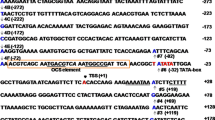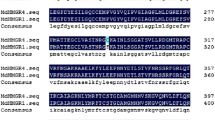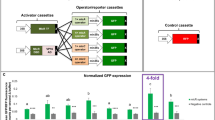Summary
Complementation of fission yeast mutants by plant genomic libraries could be a promising method for the isolation of novel plant genes. One important prerequisite is the functioning of plant promoters and terminators in Schizosaccharomyces pombe and Saccharomyces cerevisiae. Therefore, we studied the expression of the bacterial β-glucuronidase (GUS) reporter gene under the control of the Cauliflower Mosaic Virus (CaMV) 35S promoter and 35S terminator. We show here that S. pombe initiates transcription at exactly the same start site as was reported for tobacco. The 35S CaMV terminator is appropriately recognized leading to a polyadenylated mRNA of the same size as obtained in plant cells transformed with the same construct. Furthermore, the GUS-mRNA is translated into fully functional GUS protein, as determined by an enzymatic assay. Interestingly, expression of the 35S promoter in the budding yeast S. cerevisiae was found to be only moderate and about hundredfold lower than in S. pombe. To investigate whether different transcript stabilities are responsible for this enormous expression difference in the two yeasts, the 35S promoter was substituted by the ADH (alcohol dehydrogenase) promoter from fission yeast. In contrast to the differential expression pattern of the 35S promoter, the ADH promoter resulted in equally high expression rates in both fission and budding yeast, comparable to the 35S promoter in S. pombe. Since the copy number of the 35S-GUS constructs differs only by a factor of two in the two yeasts, it appears that differential recognition of the 35S promoter is responsible for the different transcription rates.
Similar content being viewed by others
References
Aviv H, Leder P (1972) Proc Natl Acad Sci USA 69: 1408–1412
Beach D, Durkacz BW, Nurse P (1982) Nature 300: 706–709
Chen EY, Seeburg PH (1985) DNA 4: 165–170
Coraggio I, Compagno C, Martegani E, Ranzi BM, Sala E, Alberghina I, Viotti A (1986) EMBO J 5: 459–465
Cramer JH, Lea K, Slightom JL (1985) Proc Natl Acad Sci USA 82: 334–338
Durkacz B, Beach D, Hayles J, Nurse P (1986) Mol Gen Genet 201: 543–545
Ecker JR, Davis RW (1986) Proc Natl Acad Sci USA 83: 5372–5376
Feinberg AP, Vogelstein B (1983) Anal Biochem 132: 6–13
Fluhr R, Kuhlemeier C, Nagy F, Chua N-H (1986) Science 232: 1106–1112
From ME, Taylor LP, Walbot V (1986) Nature 319: 791–793
Gmünder H, Kohli J (1989) Mol Gen Genet 220: 95–101
Heyer WH, Sipiczki M, Kohli J (1986) Mol Cell Biol 6: 80–89
Ito H, Fukuda Y, Murata K, Kimura A (1983) J Bacteriol 153: 163–168
Jefferson RA (1987) Plant Mol Biol Reporter 5: 387–405
Jones JDG, Dunsmuir P, Bedbrook J (1985) EMBO J 4: 2411–2418
Langridge P, Eibel H, Brown JWS, Feix G (1984) EMBO J 3: 2467–2471
Maniatis T, Fritsch EF, Sambrook J (1982) Molecular cloning: a laboratory manual. Cold Spring Harbor Laboratory, Cold Spring Harbor, New York
Müller MW, Schweyen RJ, Schmelzer C (1988) Nucleic Acids Res 16: 7383–7395
Nagata T, Okada K, Kawazu T, Takebe I (1987) Mol Gen Genet 207: 242–244
Odell JT, Nagy F, Chua N-H (1985) Nature 313: 810–812
On-Lee TM, Turgeon R, Wu R (1986) Proc Natl Acad Sci USA 83: 6815–6819
Ow DW, Jacobs JD, Howell SH (1987) Proc Natl Acad Sci USA 84: 4870–4874
Pietrzak M, Shilito RD, Hohn T, Potrykus I (1986) Nucleic Acids Res 14: 5857–5868
Pobjecky N, Rosenberg GH, Dinter-Gottlieb G, Käufer NF (1990) Mol Gen Genet 220: 314–316
Russell P, Nurse P (1986) Cell 45: 781–782
Thomas PS (1980) Proc Natl Acad Sci USA 77: 5201–5205
Wiebauer K, Herrero J-J, Fillipowicz W (1988) Mol Cell Biol 8: 2042–2051
Author information
Authors and Affiliations
Additional information
Communicated by K. Wolf
Rights and permissions
About this article
Cite this article
Hirt, H., Kögl, M., Murbacher, T. et al. Evolutionary conservation of transcriptional machinery between yeast and plants as shown by the efficient expression from the CaMV 35S promoter and 35S terminator. Curr Genet 17, 473–479 (1990). https://doi.org/10.1007/BF00313074
Received:
Issue Date:
DOI: https://doi.org/10.1007/BF00313074




